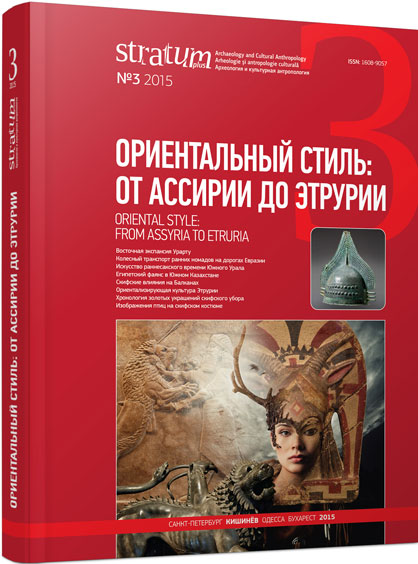Изображения редуцированной лапы животного и кисти человеческой руки в искусстве степной и лесостепной Скифии
Images of Detached Animal Paw and Human Hand in the Art of Steppe and Forest-Steppe Scythia
Author(s): Serghei V. Makhortykh, Renata RolleSubject(s): History, Archaeology, Cultural history, Ancient World
Published by: Издательский дом Stratum, Университет «Высшая антропологическая школа»
Keywords: steppe and forest-steppe Scythia; 5th century BC; animal style; bronze plaques in the form of feline paws and human hands.
Summary/Abstract: The paper examines Scythian bronze plaques of the 5th century BC in the Black Sea Coast region. It focuses on two groups of plaques, which are represented by items made in the form of feline paws and human hands. Both groups of plaques had subrectangular forms and their surfaces were divided into two parts: the narrower part was smooth, whereas the wider one was decorated with five sculptured closed fingers. Two groups differed in their sizes, the degree of surface’s profiling, the presence/absence of opposable thumbs, and the presence/absence of sculptured nails.Plaques of the first group (more than 40 items) were found on the large territory from the Volga region in the east to Central Europe in the west. The main area of their distribution was the forest-steppe on the Dnieper’s left bank and, in particular, the Vorskla’s basin. These plaques are dated by the second or third quarters of the 5th century BC. Plaques of the second group (16 items) originated from the Sula basin and the steppe areas of the Pontic region as well as the Northern Caucasus. These plaques are dated by the last quarter — the end of the 5th century BC or the first decades of the 4th century BC.Plaques of both groups originated from the local art system and belonged to the Scythian cultural context. The first group of plaques can be connected with images of felines with closed fingers on their front paws, whereas the second group was influenced by the process of antropomorphisation of the Scythian art under the influence of internal and external factors, and, in particular, the classical traditions.
Journal: Stratum plus. Археология и культурная антропология
- Issue Year: 2015
- Issue No: 3
- Page Range: 183-204
- Page Count: 22
- Language: Russian
- Content File-PDF

